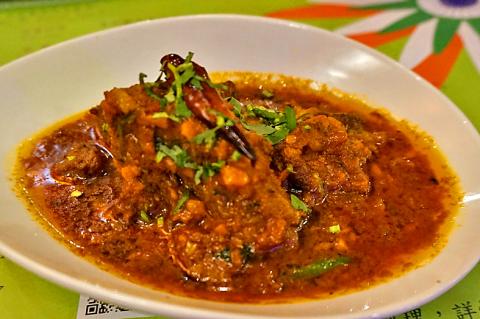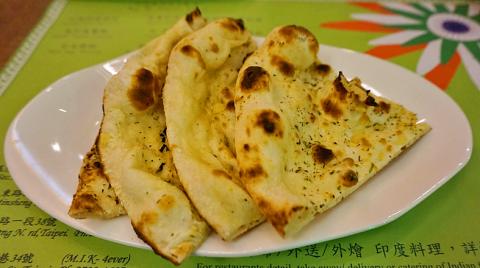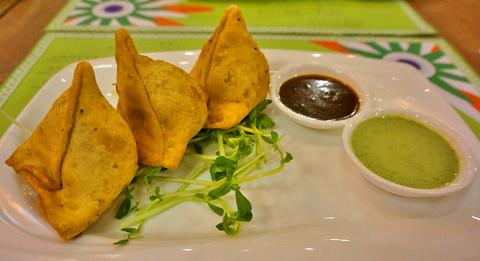Mayur Indian Kitchen tries to be a bit of everything — North Indian and South Indian cuisine, vegetarian and non-vegetarian, halal and non-halal. They have four branches, each with a different menu and concept ranging from buffet to fine dining.
While I understand the idea of wanting to showcase India’s culinary diversity, my experience has been that restaurants who cultivate a niche tend to fair much better. That being said, the dishes were still artful and flavorful, and lacked the taste of being mass produced that many restaurants who try to do a bit of everything generally fall victim to.
I dined at Mayur Indian Kitchen’s newest branch on Tonghua Street (通化街). Being technically a buffet restaurant, there are no frills, just simple red and green walls, mirrors and colorful plates. The bar top is lined with endless bottles of spices. Though modest and compact, the establishment exudes a warm, neighborhood vibe, and by virtue of its location near Tonghua Night Market (通化夜市), well-marinated pork chops is a welcome option to greasy pork sausages.

Photo: Dana Ter, Taipei Times
My dining companion and I opted for a la carte. The chef and owner, Mayur Srivastava, helped us thread through the exhaustive menu and recommend a few dishes — meat for me, vegetarian for my friend.
Of course, every Indian meal needs naan bread for dipping, so we decided on the garlic naan (NT$65). It was served fresh from the oven, crisp, fluffy and charred on the edges, the garlicy aroma adding an extra punch to the curries we paired it with. It worked well with the savory ginger taste of the chana masala (NT$245) for instance. The crunchy chickpeas were soaked in a mild curry grinded with various spices, onions and tomatoes, while small bits of ginger gave it added zest.
I quite fancied the sauces that were served with the Punjabi vegetable samosas (NT$150) — in fact, more than the samosas themselves. Both are homemade. One is a mildly sweet tamarind sauce, and the other, yogurt blended with coriander, mint, spinach and some spices. The coriander and mint were quite evident in the yogurt sauce, though not overwhelming so, but just enough to bring more pungency to the samosas. The samosa skin was not that crispy, and the potatoes and peas were quite a mouthful to digest. It was still done quite well, though the yogurt sauces were the stars of this show.

Photo: Dana Ter, Taipei Times
For vegetarians, I recommend the Tandoori vegetables (NT$280). My vegetarian friend devoured the roasted veggies, dipping each piece of mushroom, capsicum and beet into the sweet tamarind sauce. The veggies were freshly marinated and roasted in a Tandoori oven, which gave it a tantalizingly charred quality without being overcooked. The best part, though, was the cooked apple hidden inside the mountain of veggies. It was unexpected but refreshing, its softer texture complementing the capsicums.
Now, on to the meat. The chicken tikka masala (NT$325), the Indian-British fusion that was named a UK national dish in 2001, was slightly different than what I remembered eating during my graduate school days in London. There were much more vegetables, and not as much curry. While I did not mind the added veggies — the tossed capsicums, peppers and onions mixed with spices were fragrant and crunchy — I would have preferred a creamier, heavier sauce. The roasted chicken was still elegantly done, tender and chewy.
The beef vindaloo (NT$350) was one of my favorite meat dishes. The strips of beef were nicely shredded and tender. The Goan-style curry it was soaked in was a delectable blend of sour and spicy. Also worth sampling is the roasted pork chops (NT$350). Marinated in barbecue sauce and served with fennel seeds, the pork chops tasted naturally sweet and were slightly charred and crisp around the edges.

Photo: Dana Ter, Taipei Times
Definitely check out Mayur Indian Kitchen’s Tonghua Street branch if you’re looking for a full, satisfying meal of curries and veggies. Sometimes, more is more.

Late last month Philippines Foreign Affairs Secretary Theresa Lazaro told the Philippine Senate that the nation has sufficient funds to evacuate the nearly 170,000 Filipino residents in Taiwan, 84 percent of whom are migrant workers, in the event of war. Agencies have been exploring evacuation scenarios since early this year, she said. She also observed that since the Philippines has only limited ships, the government is consulting security agencies for alternatives. Filipinos are a distant third in overall migrant worker population. Indonesia has over 248,000 workers, followed by roughly 240,000 Vietnamese. It should be noted that there are another 170,000

Hannah Liao (廖宸萱) recalls the harassment she experienced on dating apps, an experience that left her frightened and disgusted. “I’ve tried some voice-based dating apps,” the 30-year-old says. “Right away, some guys would say things like, ‘Wanna talk dirty?’ or ‘Wanna suck my d**k?’” she says. Liao’s story is not unique. Ministry of Health and Welfare statistics show a more than 50 percent rise in sexual assault cases related to online encounters over the past five years. In 2023 alone, women comprised 7,698 of the 9,413 reported victims. Faced with a dating landscape that can feel more predatory than promising, many in

“This is one of those rare bits of TikTok fitness advice with a lot of truth behind it,” says Bethan Crouse, performance nutritionist at Loughborough University. “Sometimes it’s taken a bit too literally, though! You see people chugging protein drinks as they’re scanning out of their gym.” Crouse recommends the athletes she works with consume 20-30g of protein within 30-60 minutes of finishing a resistance training session. “The act of exercising our muscles increases the breakdown of muscle proteins,” she says. “In order to restore, or hopefully improve them — and get gains such as increased muscle mass or strength —

“Far from being a rock or island … it turns out that the best metaphor to describe the human body is ‘sponge.’ We’re permeable,” write Rick Smith and Bruce Lourie in their book Slow Death By Rubber Duck: The Secret Danger of Everyday Things. While the permeability of our cells is key to being alive, it also means we absorb more potentially harmful substances than we realize. Studies have found a number of chemical residues in human breast milk, urine and water systems. Many of them are endocrine disruptors, which can interfere with the body’s natural hormones. “They can mimic, block